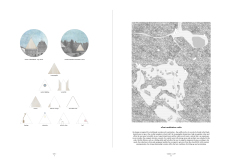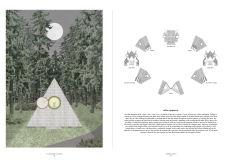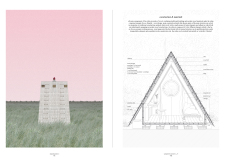5 key facts about this project
At its core, the project serves as a multifunctional space that accommodates various activities and interactions. Whether it is a gathering place, a workspace, or an artistic venue, the architecture is designed to facilitate a diverse range of functions while maintaining a coherent identity. This versatility is achieved through strategic spatial planning that prioritizes accessibility and ease of movement. Open floor plans combined with well-defined zones allow for fluid transitions between different areas, encouraging engagement and collaboration among users.
The materiality of the project is an essential aspect of its identity, showcasing a careful selection of materials that speak to both durability and sustainability. The use of locally sourced stone provides a sense of permanence and connects the building to the landscape, while large expanses of glass open the interior to the outside, promoting natural light and visual continuity with the surroundings. Sustainable practices are evident, with materials chosen not only for their structural capabilities but also for their environmentally friendly attributes. These decisions contribute to the overall efficiency of the building, ensuring that it minimizes its ecological footprint.
Unique design approaches have been employed throughout the project, showcasing a strong emphasis on context and community. The exterior incorporates elements that reflect the local architectural language, such as traditional patterns and forms, reimagined in a contemporary context. This conscious effort to blend the new with the familiar fosters a sense of belonging and pride within the community. The roofscape is particularly notable, featuring an intricate design that not only enhances the visual interest of the building but also serves environmental purposes, such as rainwater harvesting and energy generation.
Interior space planning is executed with an acute awareness of human scale and comfort. The distribution of natural light through strategically positioned windows and skylights creates a warm and inviting atmosphere, allowing inhabitants to feel connected to nature even while indoors. A careful selection of furnishings complements the architectural design, with tactile and visually appealing elements that enhance user comfort and usability.
Furthermore, the landscape surrounding the project is an integral part of the overall architectural experience. Landscaping elements include native plantings and green spaces that promote biodiversity and offer recreational opportunities. These areas provide soft transitions between the built environment and the natural landscape, encouraging outdoor activities and community gatherings.
This architectural project stands as a testament to thoughtful design, embracing an approach that respects ecological values while fostering community interaction. Every detail, from the selection of materials to the arrangement of spaces, has been meticulously considered to achieve a harmonious balance between functionality and aesthetic appeal. The overall effect is a holistic architectural experience that not only meets the needs of its users but also contributes positively to the surrounding environment.
For those interested in diving deeper into the various elements of this architectural marvel, exploring the architectural plans, sections, and detailed designs could provide further insights into the innovative ideas and methodologies behind this project. Engaging with these components will offer a richer understanding of how the design decisions were made and the vision that guided the project from inception to fruition.


























